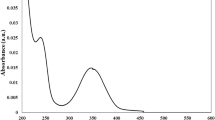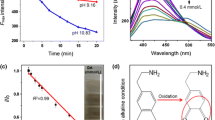Abstract
In this study, some effort has been performed to provide low temperature, less time consuming and facile routes for the synthesis of CdTe quantum dots using ultrasound and water soluble capping agent thioglycolic acid. TGA-capped CdTe quantum dots were characterized through x-ray diffraction, transmission electron microscopy, Fourier transform infrared, ultraviolet-visible and fluorescence spectroscopy. The prepared quantum dots were used for warfarin determination based on the quenching of the fluorescence intensity in aqueous solution. Under the optimized conditions, the linear range of quantum dots fluorescence intensity versus the concentration of warfarin was 0.1–160.0 μM, with the correlation coefficient of 0.9996 and a limit of detection of 77.5 nM. There was no interference to coexisting foreign substances. The selectivity of the sensor was also tested and the results show that the developed method possesses a high selectivity for warfarin.














Similar content being viewed by others
References
Murray CB, Kagan C, Bawendi M (2000) Synthesis and characterization of monodisperse nanocrystals and close-packed nanocrystal assemblies. Annua Rev Mater Sci 30:545–610
Sai Y, Siva Kishore N, Dattatreya A, Anand S, Sridhari G (2011) A review on biotechnology and its commercial and industrial applications. J Biotechnol Biomater 1:1–5
Reed M, Randall J, Aggarwal R, Matyi R, Moore T, Wetsel A (1988) Observation of discrete electronic states in a zero-dimensional semiconductor nanostructure. Phys Rev Lett 60:535–537
Gao X, Chung LW, Nie S (2007) Quantum dots for in vivo molecular and cellular imaging. In: Quantum dots. Springer pp 135–145
Esteve-Turrillas FA, Abad-Fuentes A (2013) Applications of quantum dots as probes in immunosensing of small-sized analytes. Biosens Bioelectron 41:12–29
Chakravarthy KV, Davidson BA, Helinski JD, Ding H, Law WC, Yong KT, Prasad PN, Knight PR (2011) Doxorubicin-conjugated quantum dots to target alveolar macrophages and inflammation. Nanomede: Nanotechnol Biol Med 7:88–96
Adeli M, Hakimpoor F, Parsamanesh M, Kalantari M, Sobhani Z, Attyabi F (2011) Quantum dot-pseudopolyrotaxane supramolecules as anticancer drug delivery systems. Polymer 52:2401–2413
Erogbogbo F, Yong KT, Roy I, Xu G, Prasad PN, Swihart MT (2008) Biocompatible luminescent silicon quantum dots for imaging of cancer cells. ACS Nano 2:873–878
Bharali DJ, Lucey DW, Jayakumar H, Pudavar HE, Prasad PN (2005) Folate-receptor-mediated delivery of InP quantum dots for bioimaging using confocal and two-photon microscopy. J Am Chem Soc 127:11364–11371
Liu Z, Liu S, Wang X, Li P, He Y (2013) A novel quantum dots-based OFF–ON fluorescent biosensor for highly selective and sensitive detection of double-strand DNA. Sens Actuators B Chem 176:1147–1153
Dyadyusha L, Yin H, Jaiswal S, Brown T, Baumberg J, Booy F, Melvin T (2005) Quenching of CdSe quantum dot emission, a new approach for biosensing. Chem Commun 25:3201–3203
Sharma A, Pandey CM, Sumana G, Soni U, Sapra S, Srivastava A, Chatterjee T, Malhotra BD (2012) Chitosan encapsulated quantum dots platform for leukemia detection. Biosens Bioelectron 38:107–113
Samia AC, Chen X, Burda C (2003) Semiconductor quantum dots for photodynamic therapy. J Am Chem Soc 125:15736–15737
Jin T, Sun D, Su J, Zhang H, Sue HJ (2009) Antimicrobial efficacy of zinc oxide quantum dots against Listeria monocytogenes, Salmonella enteritidis, and Escherichia coli O157: H7. J Food Sci 74:M46–M52
Biju V, Anas A, Akita H, Shibu ES, Itoh T, Harashima H, Ishikawa M (2012) FRET from quantum dots to photodecompose undesired acceptors and report the condensation and decondensation of plasmid DNA. ACS Nano 6:3776–3788
Wang Y, Chen L (2011) Quantum dots, lighting up the research and development of nanomedicine. Nanomed: Nanotechnol Biol Med 7:385–402
Gerbec JA, Magana D, Washington A, Strouse GF (2005) Microwave-enhanced reaction rates for nanoparticle synthesis. J Am Chem Soc 127:15791–15800
Horikoshi S, Serpone N (2013). Microwaves in nanoparticle synthesis: fundamentals and applications. Wiley
Xu H, Zeiger BW, Suslick KS (2013) Sonochemical synthesis of nanomaterials. Chem Soc Rev 42:2555–2567
Kuang H, Zhao Y, Ma W, Xu L, Wang L, Xu C (2011) Recent developments in analytical applications of quantum dots. TrAC Trends Anal Chem 30:1620–1636
Gaponik N, Rogach AL (2010) Thiol-capped CdTe nanocrystals: progress and perspectives of the related research fields. Phys Chem Chem Phys 12:8685–8693
Chen D, Sharma SK, Mudhoo A (2011) Handbook on applications of ultrasound: Sonochemistry for sustainability. CRC press
Wang H, Zhu JJ, Zhu JM, Chen HY (2002) Sonochemical method for the preparation of bismuth sulfide nanorods. J Phys Chem B 106:3848–3854
Zhu JJ, Wang H, Xu S, Chen HY (2002) Sonochemical method for the preparation of monodisperse spherical and rectangular lead selenide nanoparticles. Langmuir 18:3306–3310
Zhao WB, Zhu JJ, Chen HY (2003) Photochemical preparation of rectangular PbSe and CdSe nanoparticles. J Cryst Growth 252:587–592
Qiu X, Burda C, Fu R, Pu L, Chen H, Zhu J (2004) Heterostructured Bi2Se3 nanowires with periodic phase boundaries. J Am Chem Soc 126:16276–16277
Kaminsky LS, Zhang ZY (1997) Human P450 metabolism of warfarin. Pharmacol Ther 73:67–74
Takahashi H, Kashima T, Kimura S, Muramoto N, Nakahata H, Kubo S, Shimoyama Y, Kajiwara M, Echizen H (1997) Determination of unbound warfarin enantiomers in human plasma and 7-hydroxywarfarin in human urine by chiral stationary-phase liquid chromatography with ultraviolet or fluorescence and on-line circular dichroism detection. J Chromatogr B 701:71–80
Osman A, Arbring K, Lindahl TL (2005) A new high-performance liquid chromatographic method for determination of warfarin enantiomers. J Chromatogr B 826:75–80
Locatelli I, Kmetec V, Mrhar A, Grabnar I (2005) Determination of warfarin enantiomers and hydroxylated metabolites in human blood plasma by liquid chromatography with achiral and chiral separation. J Chromatogr B 818:191–198
Hou J, Zheng J, Shamsi SA (2007) Separation and determination of warfarin enantiomers in human plasma using a novel polymeric surfactant for micellar electrokinetic chromatography–mass spectrometry. J Chromatogr A 1159:208–216
Zare S (2014) M.S. Thesis, Ultrasonic- and microwave-assisted synthesis of different CdSe and CdTe quantum dots for chiral, molecular and biomolecular sensing, Shiraz University, Shiraz, Iran,
Zhang H, Zhou Z, Yang B, Gao M (2003) The influence of carboxyl groups on the photoluminescence of mercaptocarboxylic acid-stabilized CdTe nanoparticles. J Phys Chem B 107:8–13
Gao M, Kirstein S, Möhwald H, Rogach AL, Kornowski A, Eychmüller A, Weller H (1998) Strongly photoluminescent CdTe nanocrystals by proper surface modification. J Phys Chem B 102:8360–8363
Idowu M, Lamprecht E, Nyokong T (2008) Interaction of water-soluble thiol capped CdTe quantum dots and bovine serum albumin. J Photochem Photobiol A Chem 198:7–12
Samia A, Dayal S, Burda C (2006) Quantum dot‐based energy transfer: perspectives and potential for applications in photodynamic therapy, Ph. J Photochem Photobiol 82:617–625
Li MY, Zhou HM, Zhang HY, Sun P, Yi KY, Wang M, Dong ZZ, Xu SK (2010) Preparation and purification of l-cysteine capped CdTe quantum dots and its self-recovery of degenerate fluorescence. J Lumin 130:1935–1940
Wang Y, Liu S (2012) One-pot synthesis of highly luminescent CdTe quantum dots using sodium tellurite as tellurium source in aqueous solution. J Chil Chem Soc 57:1109–1112
Jhonsi MA, Renganathan R (2010) Investigations on the photoinduced interaction of water soluble thioglycolic acid (TGA) capped CdTe quantum dots with certain porphyrins. J Colloid Interface Sci 344:596–602
Joseph RL, Lakowicz R (1999) Principles of fluorescence spectroscopy, vol 11. Kluwer Academic/Plenum Publishers, New York
Wang Q, Yu X, Zhan G, Li C (2014) Fluorescent sensor for selective determination of copper ion based on N-acetyl-l-cysteine capped CdHgSe quantum dots. Biosens Bioelectron 54:311–316
Sorouraddin MH, Imani-Nabiyyi A, Najibi-Gehraz SA, Rashidi MR (2014) A new fluorimetric method for determination of valproic acid using TGA-capped CdTe quantum dots as proton sensor. J Lumin 145:253–258
Ghambari H, Hadjmohammadi MR (2012) Low-density solvent-based dispersive liquid-liquid microextraction followed by high performance liquid chromatography for determination of warfarin in human plasma. J Chromatogr B 899:66–71
Lomonac T, Ghimenti S, Piga I, Onor M, Melai B, Fuoco R, Francesco FD (2013) Determination of total and unbound warfarin and warfarin alcohols in human plasma by high performance liquid chromatography withfluorescence detection. J Chromatogr A 1314:54–62
Yau WP, Chan E (2002) Chiral CE separation of warfarin in albumin containing samples. J Pharm Biomed Anal 28:107–123
Rezaei B, Rahmanian O, Ensafi AA (2014) An electrochemical sensor based on multiwall carbon nanotubes andmolecular imprinting strategy for warfarin recognition and determination. Sens Actuators B 196:539–545
Chang Z, Yan HT (2012) Cloud pointextraction fluorimetric combined methodology for the determination of trace warfarin based on the sensitization effect of supramolecule. J Lumin 132:811–817
Radwan MA, Bawazeer GA, Aloudah NM, AlQuadeib BT, Aboul‐Enein HY (2012) Determination of free and total warfarin concentrations in plasma using UPLC MS/MS and its application to a patient samples. Biomed Chromatogr 26:6–11
Smirnova TD, Nevryueva NV, Shtykov SN, Kochubei VI, Zhemerichkin DA (2009) Determination of warfarin by sensitized fluorescence using organized media. J Anal Chem 64:1114–1119
Sastry CSP, Rao TT, Sailaja A, Rao JV (1991) Micro-determination of warfarin sodium, nicoumalone and acebutolol hydrochloride in pharmaceutical preparations. Talanta 38:1107–1109
Pacheco ME, Bruzzone L (2014) Room temperature phosphorescence quenching study of coumarins. Indirect determination of warfarin in pharmaceuticals. Anal Methods 6:3462–3466
Panaderoa S, Hens G, Perez-Bendito D (1993) Simultaneous determination of warfarin and bromadiolone by derivative synchronous fluorescence spectrometry. Talanta 4:225–230
Acknowledgments
We gratefully acknowledge the support of this work by Shiraz University Research Council
Author information
Authors and Affiliations
Corresponding author
Rights and permissions
About this article
Cite this article
Dehbozorgi, A., Tashkhourian, J. & Zare, S. Fluorescence Determination of Warfarin Using TGA-capped CdTe Quantum Dots in Human Plasma Samples. J Fluoresc 25, 1887–1895 (2015). https://doi.org/10.1007/s10895-015-1681-3
Received:
Accepted:
Published:
Issue Date:
DOI: https://doi.org/10.1007/s10895-015-1681-3




